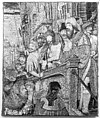Christ Shown to the People
After a painting by Quentin Metsys Netherlandish
Not on view
Though this tapestry’s edges have been cut, very little of its design is missing, except for a likely border. A hardly visible inscription gives voice to the grimacing, gesticulating, jeering crowd, thronging around the barely clothed figure of Jesus Christ: “ECCE HOMO”- ‘Here is the Man’- is woven in gilded silver metal-wrapped threads immediately below his representation, as if hovering in front of the patterned balustrade. The architecture’s veined marbles and carved ornamentation, and the myriad textures of clothing, all create effects of rich patterning characteristic of established tapestry design conventions. The tapestry’s claustrophobically cropped, half-length composition and sharply receding perspective, on the other hand, have as much in common with early Netherlandish panel painting. Indeed, this tapestry is based upon a painted design executed in multiple versions in the workshop of the painter, Quentin Metsys; one of the most well-known examples is in the collection of the Museo del Prado, Madrid.
As such, this is one of a sizeable group of smaller-scale devotional tapestries (like 06.301 also at The Met) produced by talented weavers almost certainly working in Brussels- the center of excellence for figurative tapestry weaving throughout the later fifteenth and the sixteenth centuries- probably made on speculation for sale on the open market. Representing the scene recounted in the Biblical book of John, 19:5, when the Roman governor, Pontius Pilate, showed the arrested Christ to the people, mockingly crowned with thorns, just before his execution, this subject matter was ideal for the tapestry’s privileged owner to contemplate and use as a devotional tool, meditating on the narrative of Christ’s sacrifice.
Due to rights restrictions, this image cannot be enlarged, viewed at full screen, or downloaded.

